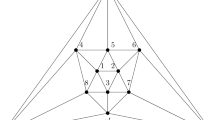Abstract
A set S of vertices of a graph G=(V,E) without isolated vertex is a total dominating set if every vertex of V(G) is adjacent to some vertex in S. The total domination number γ t (G) is the minimum cardinality of a total dominating set of G. The total domination subdivision number \(\mathrm{sd}_{\gamma_{t}}(G)\) is the minimum number of edges that must be subdivided (each edge in G can be subdivided at most once) in order to increase the total domination number. Favaron, Karami, Khoeilar and Sheikholeslami (J. Comb. Optim. 20:76–84, 2010a) conjectured that: For any connected graph G of order n≥3, \(\mathrm{sd}_{\gamma_{t}}(G)\le \gamma_{t}(G)+1\). In this paper we use matching to prove this conjecture for graphs with no 3-cycle and 5-cycle. In particular this proves the conjecture for bipartite graphs.
Similar content being viewed by others
References
Favaron O, Karami H, Sheikholeslami SM (2007) Total domination and total domination subdivision numbers of graphs. Australas J Combin 38:229–235
Favaron O, Karami H, Khoeilar R, Sheikholeslami SM (2009) A new upper bound for total domination subdivision numbers. Graphs Comb 25:41–47
Favaron O, Karami H, Khoeilar R, Sheikholeslami SM (2010a) On the total domination subdivision number in some classes of graphs. J Comb Optim 20:76–84
Favaron O, Karami H, Khoeilar R, Sheikholeslami SM (2010b) Matching and total domination subdivision number of graphs with few C 4. Discuss Math, Graph Theory 30:611–618
Favaron O, Karami H, Sheikholeslami SM (2011) Bounding the total domination subdivision number of a graph in terms of its order. J Comb Optim 21:209–218
Haynes TW, Hedetniemi ST, van der Merwe LC (2003) Total domination subdivision numbers. J Comb Math Comb Comput 44:115–128
Haynes TW, Henning MA, Hopkins LS (2004a) Total domination subdivision numbers of graphs. Discuss Math, Graph Theory 24:457–467
Haynes TW, Henning MA, Hopkins LS (2004b) Total domination subdivision numbers of trees. Discrete Math 286:195–202
Karami H, Khodkar A, Khoeilar R, Sheikholeslami SM (2008) Trees whose total domination subdivision number is one. Bull Inst Comb Appl 53:57–67
Karami H, Khodkar A, Sheikholeslami SM (2011) An upper bound for total domination subdivision numbers of graphs. Ars Comb 102:321–331
Lovász L, Plummer MD (1986) Matching theory. Annals of discrete math, vol 29. North Holland, Amsterdam
Sheikholeslami SM (2010) On the total domination subdivision number of a graph. Cent Eur J Math 8:468–473
Tutte WT (1947) The factorization of linear graphs. J Lond Math Soc 22:107–111
Velammal S (1997) Studies in graph theory: covering, independence, domination and related topics. PhD Thesis, Manonmaniam Sundaranar University, Tirunelveli
West DB (2000) Introduction to graph theory. Prentice-Hall, New York
Author information
Authors and Affiliations
Corresponding author
Additional information
This research was in part supported by a grant from IPM (No. 90050043).
Rights and permissions
About this article
Cite this article
Karami, H., Khoeilar, R. & Sheikholeslami, S.M. The total domination subdivision number in graphs with no induced 3-cycle and 5-cycle. J Comb Optim 25, 91–98 (2013). https://doi.org/10.1007/s10878-011-9421-3
Published:
Issue Date:
DOI: https://doi.org/10.1007/s10878-011-9421-3




